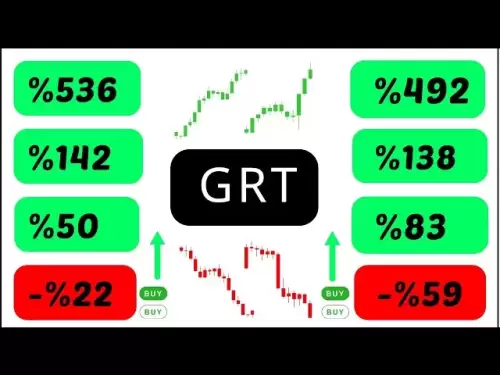 |
|
 |
|
 |
|
 |
|
 |
|
 |
|
 |
|
 |
|
 |
|
 |
|
 |
|
 |
|
 |
|
 |
|
 |
|
Cryptocurrency News Articles
Qubetics Emerges as a Front-Runner by Solving Blockchain Fragmentation with Its Unified Interoperability Suite
May 26, 2025 at 05:15 am
The digital asset landscape continues to mature as more projects align technical breakthroughs with real-world utility.
The digital asset landscape continues to mature as more projects align technical breakthroughs with real-world utility. As global adoption ramps up and market fundamentals shift, participants are increasingly looking for substance behind speculative spikes. This weekend, a number of strategic protocols are showing signs of structural momentum—driven by development updates, robust infrastructure scaling, and new use cases built for longevity.
This analysis compares three highly active projects gaining relevance in the current macro-cycle. Two—Avalanche and Polygon—are well-established layer-1 and layer-2 platforms undergoing notable upgrades and partnerships. But one project is drawing particular interest from analysts focused on utility-first development: Qubetics. This emerging contender isn’t just making noise with presale funding figures—it’s gaining traction for its developer-focused tools like QubeQode and the Qubetics IDE, and its mission to unify blockchain silos into a truly interoperable Web3 environment.
As participants narrow their focus to meaningful long-term plays, Qubetics stands out as a front-runner among the best altcoins to buy this weekend. With price discovery still in its infancy and utility at the forefront, it could be one of the few emerging assets combining strong architecture with realistic return projections.
1. Qubetics — Reengineering Blockchain Utility with QubeQode and Qubetics IDE
Qubetics is emerging as a core infrastructure project aimed at solving the fragmentation across blockchains by offering a comprehensive interoperability suite. Central to this mission is QubeQode, a next-gen Web3 smart contract programming framework designed for multichain deployment from a single codebase. It drastically simplifies how developers build, test, and deploy on networks like Ethereum, Solana, Avalanche, and others—all from a unified environment.
Alongside QubeQode, the Qubetics IDE delivers an enterprise-grade experience for smart contract development with built-in auditing tools, simulation environments, and plugin support for decentralized front-end frameworks. Together, these innovations provide a seamless experience for institutions, DAOs, and startups seeking to build and scale securely across multiple ecosystems.
These tools make Qubetics more than just a blockchain—it’s an enablement layer built for the next wave of applications. Whether it’s a fintech protocol launching on both EVM and Cosmos chains or a supply chain system integrating tokenized assets on Tezos and Avalanche, Qubetics provides the infrastructure to make it happen. As this backbone role becomes more vital in a multichain world, analysts are increasingly categorizing Qubetics among the best altcoins to buy this weekend, especially given its low entry price and enterprise alignment.
The project’s interoperability focus goes far beyond marketing language. As Web3 matures, the ability for protocols to bridge ecosystems—without sacrificing security or performance—will define winners from legacy chains. And in that scenario, Qubetics appears to be structurally positioned for long-term dominance.
2. Avalanche — Scaling Modular Networks Through the Fusion Initiative
Avalanche has re-entered the spotlight with the announcement of its $100 million Fusion initiative, a program designed to launch modular blockchain networks that can plug directly into the Avalanche consensus layer. Modular chains are being heralded as the future of scalable architecture, and Avalanche’s proactive approach positions it well among layer-1s seeking to compete with Ethereum and Cosmos zones.
The Fusion program provides funding, architecture support, and customized integrations for projects that want to launch their own subnet without sacrificing composability. Avalanche’s signature consensus engine allows for lightning-fast finality and near-zero fees, making it a prime candidate for both DeFi protocols and enterprise use cases in gaming, identity, and data provenance.
From a growth standpoint, Avalanche is showing signs of network maturation. Subnet adoption is accelerating, the total number of validators has increased steadily over the last quarter, and institutional pilots continue to surface in Asia and Europe. These structural indicators suggest that Avalanche is not only innovating but also maintaining momentum—giving it a strong case among near-term rotation picks.
While price movements remain tethered to broader market liquidity, the on-chain metrics signal resilience. For participants looking to balance innovation exposure with a proven architecture, Avalanche offers one of the more compelling options this weekend.
3. Polygon — Infrastructure That Powers Ethereum’s Mass Adoption Layer
Polygon remains a foundational piece of Ethereum’s scaling roadmap and continues to evolve with significant protocol updates, including the gradual rollout of Polygon 2.0, which introduces a next-gen zero-knowledge proof mechanism and a unified liquidity layer across all chains built on the network.
The shift to zkEVM has been instrumental in enabling large-scale application deployment with cheaper fees and faster settlement times. In addition, partnerships with traditional enterprises like Stripe, Reddit, and Nike have strengthened Polygon’s market position, pushing it well beyond the DeFi space and into retail, social, and real-world brand integration.
Recent development activity shows no slowdown either. The team’s modular tooling and compatibility with existing EVM
Disclaimer:info@kdj.com
The information provided is not trading advice. kdj.com does not assume any responsibility for any investments made based on the information provided in this article. Cryptocurrencies are highly volatile and it is highly recommended that you invest with caution after thorough research!
If you believe that the content used on this website infringes your copyright, please contact us immediately (info@kdj.com) and we will delete it promptly.





























































